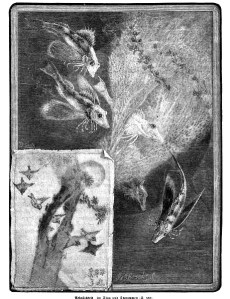Only when they leap in the air do flying fish, with their small, box-like heads and gunmetal-gray bodies, betray their avian affinities. Aloft on broad pectoral fins, they sail just above the ocean waves. Should an impediment in the form of a ship cross their path, they in a body take flight in order to avoid it, rising as a glittering, undulating cloud to glide diagonally to the ship’s course, against the wind and seemingly also against gravity. Rough seas prod flying fish to greater feats: They glide without ever touching water, thus behaving more like gulls than like any gilled creature.
The singular ability of flying fish has occasioned rather fanciful speculation by some of history’s most formidable philosophical and literary minds. Aristotle conjectured that flying fish spent their days in their watery environs but decamped at night for dry land. And Victor Hugo likely drew from them inspiration for the seaside reflections of Gilliatt, the meditative Guernseyman of his 1866 novel, The Toilers of the Sea. Gilliatt refused to believe the air a “mere desert.” He thought it must be teeming, rather, with “creatures colorless and transparent.” Indeed, this “man of dreams” sees no evidence to suggest why this should not be the case. “Since the water is is filled with life,” he wonders, “why not the atmosphere?” After all, the sea harbors creatures which, out of the water, resemble “soft crystal,” and when returned to their natural habitat disappear in “that medium by reason of their identity in transparency and color.” Why then cannot other transparencies inhabit the air? If men were to “fish the air as we fish the depths of the sea,” Gilliatt argues, “we should discover a multitude of strange animals.” Upon such discovery, he concludes, “many things would be made clear.”
When not engaged in metaphysical speculation on the nature of etheric beings Gilliatt earns a living by harvesting the sea’s bounty. His skill in that trade is such that he often brings home “heavy takes of fish,” which he shares with the poor of the island — who, it should be noted, “were little grateful” to receive these donations.
The ingratitude of the needy proceeds from their distrust of Gilliatt, whom they consider strange, as well as possessed of unnaturally good luck. Whatever their attitude toward him, the Guernsey poor would no doubt find their condition remedied upon the discovery that the odd fisherman’s daydreams are correct: Creatures do exist that swim the air as fish do the sea. The air would become, then, a second hunting ground from which humankind could draw sustenance. Having the air to “fish” as well as the sea, even the most unfortunate would never again know want. Growning under their sumptuous burdens, the poors’ tables and cupboards would be mere deserts no longer.
An 1875 issue of The Guernsey Magazine reports that most of the creatures caught in the familiar medium of the sea were mackerel, which “abounds round the island.” Perhaps the beneficiaries of Gilliatt’s largess fixed dishes similar to this recipe for baked mackerel from the 1865 tome, Mrs. Beeton’s Dictionary of Every-Day Cookery.
Baked Mackerel
279. Ingredients. 4 middling-sized mackerel, a nice delicate forcemeat … 3 oz. of butter; pepper and salt to taste.
Mode.—Clean the fish, take out the roes, and fill up with forcemeat, and sew up the slit. Flour, and put them in a dish, heads and tails alternately, with the roes; and, between each layer, put some little pieces of butter, and pepper and salt. Bake for an hour, and either serve with plain melted butter or a maitre d’hotel sauce.
Time.—1/2 hour. Average cost for this quantity, 1s. 10d.
Seasonable from April to July.
Sufficient for 6 persons.
Note.—Baked mackerel may be dressed in the same way as baked herrings … and may also be stewed in wine.
Weight Of The Mackerel.—The greatest weight of this fish seldom exceeds 2 lbs., whilst their ordinary length runs between 14 and 20 inches. They die almost immediately after they are taken from their element, and, for a short time, exhibit a phosphoric light.

Would you rather receive The Austerity Kitchen by email? Then sign up for my Substack.
And, if you’d like to help the Kitchen keep cookin’, please consider picking up copies of my books, Why Fast? and Fermented Foods.


